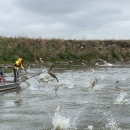Species that are considered high risk have a well-documented history of invasiveness in at least one location globally, and a high or medium climate match to the contiguous United States.
White perch (Morone americana) is a fish native to the East Coast of the United States and Canada; it can inhabit fresh, brackish and coastal waters. This assessment is applicable only to landlocked populations and the freshwater stages of other populations. This species can reproduce successfully in freshwater. M. americana is utilized in both commercial and sport fisheries. The life history is plastic; shifts have been documented corresponding to invasion stages and other environmental conditions. M. americana has been reported as a host for many diseases and parasites; of particular note is the probable host status and susceptibility of the species to viral haemorrhagic septicaemia (VHS). The history of invasiveness is high. M. americana has spread to other areas east of the Rocky Mountains by bait fish release, intentional stocking, and fish movement through man-made and natural hydrologic connections. Several types of impacts have been documented for this species. M. americana has impacted abundance of an amphipod in the Bay of Quinte, Lake Ontario. Significant declines in native fish abundance have also been documented after M. americana invasion. It has been implicated in the decline of at least one walleye fishery. Hybridization between M. americana and two other native Morone spp. have been documented with the hybrids being reproductively viable. Climate match with the contiguous United States is high. The only areas of low match were along the Pacific Coast. The certainty of assessment is high. The biology, distribution, and history of invasiveness is well-documented in the literature. The overall risk for this species is high.



